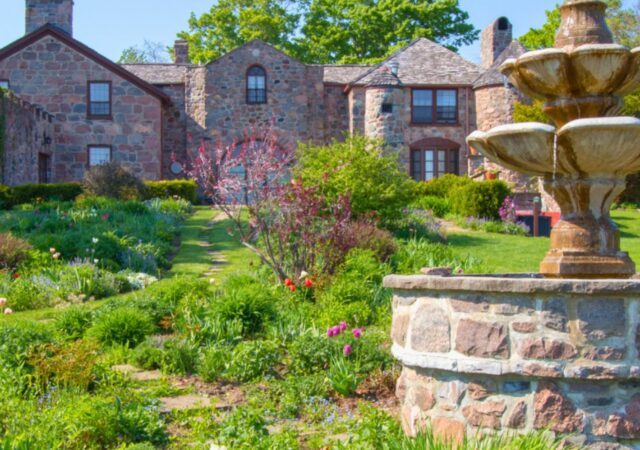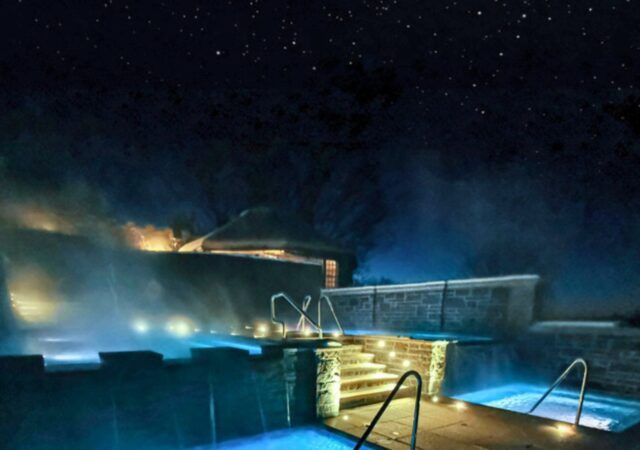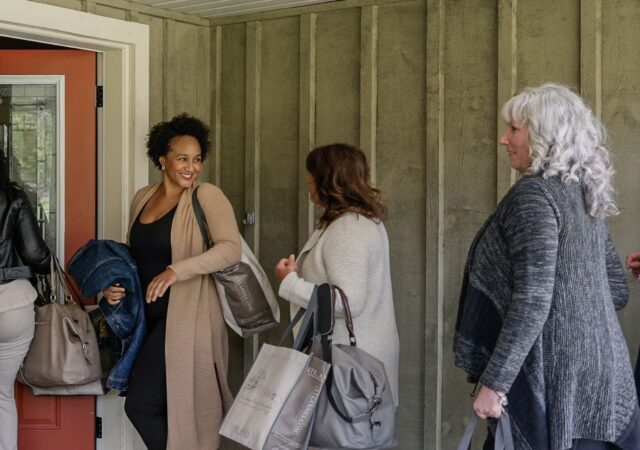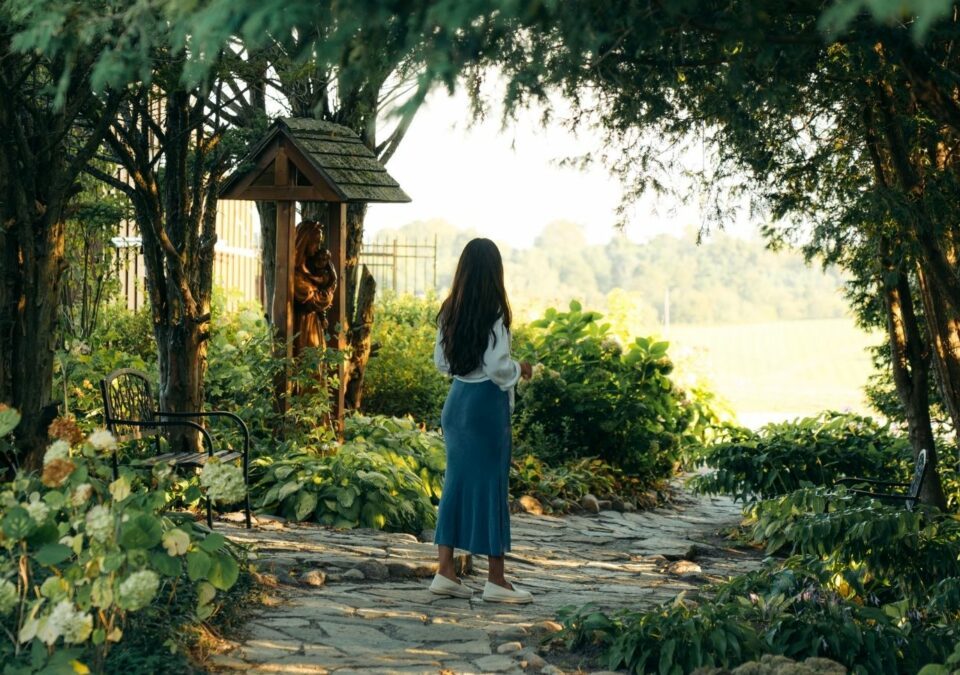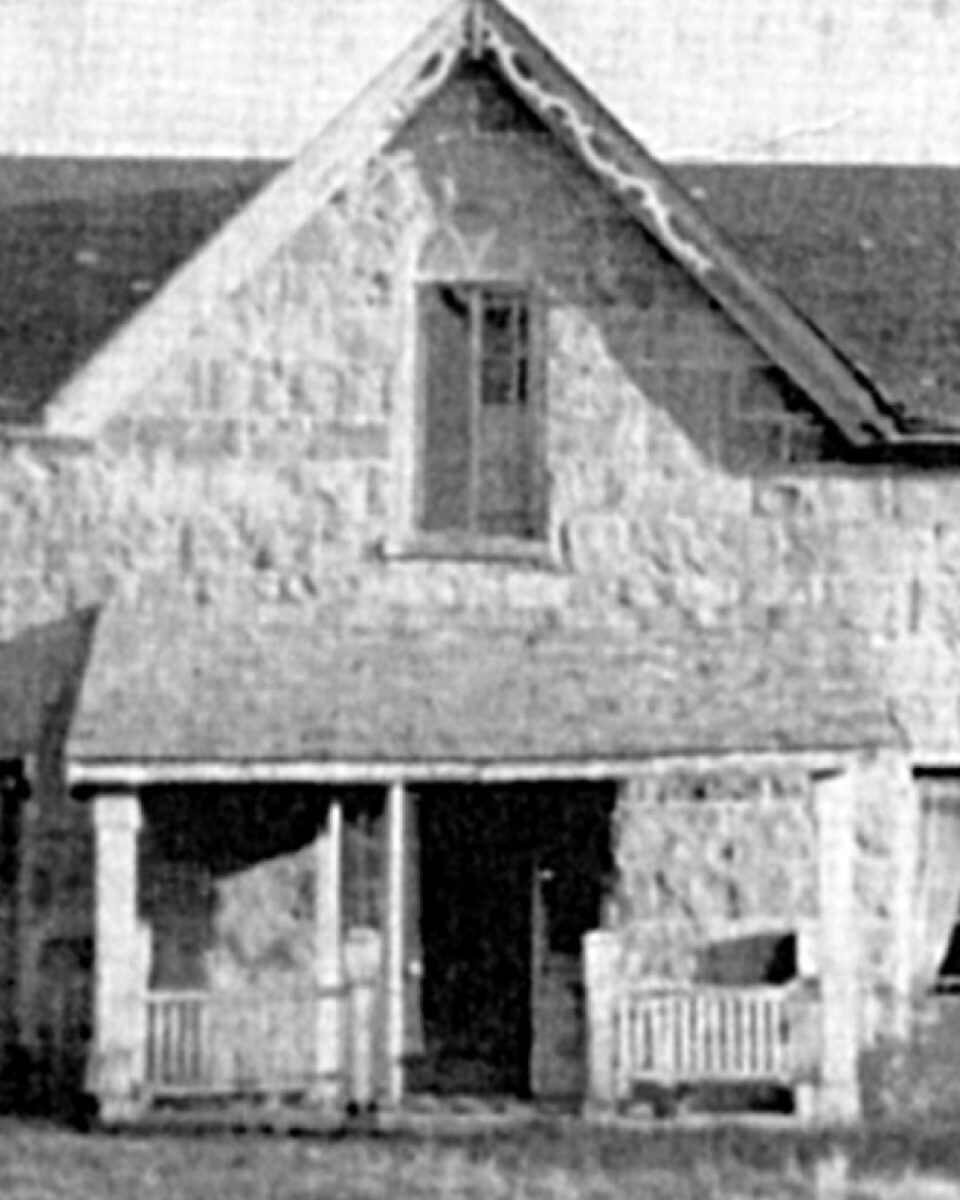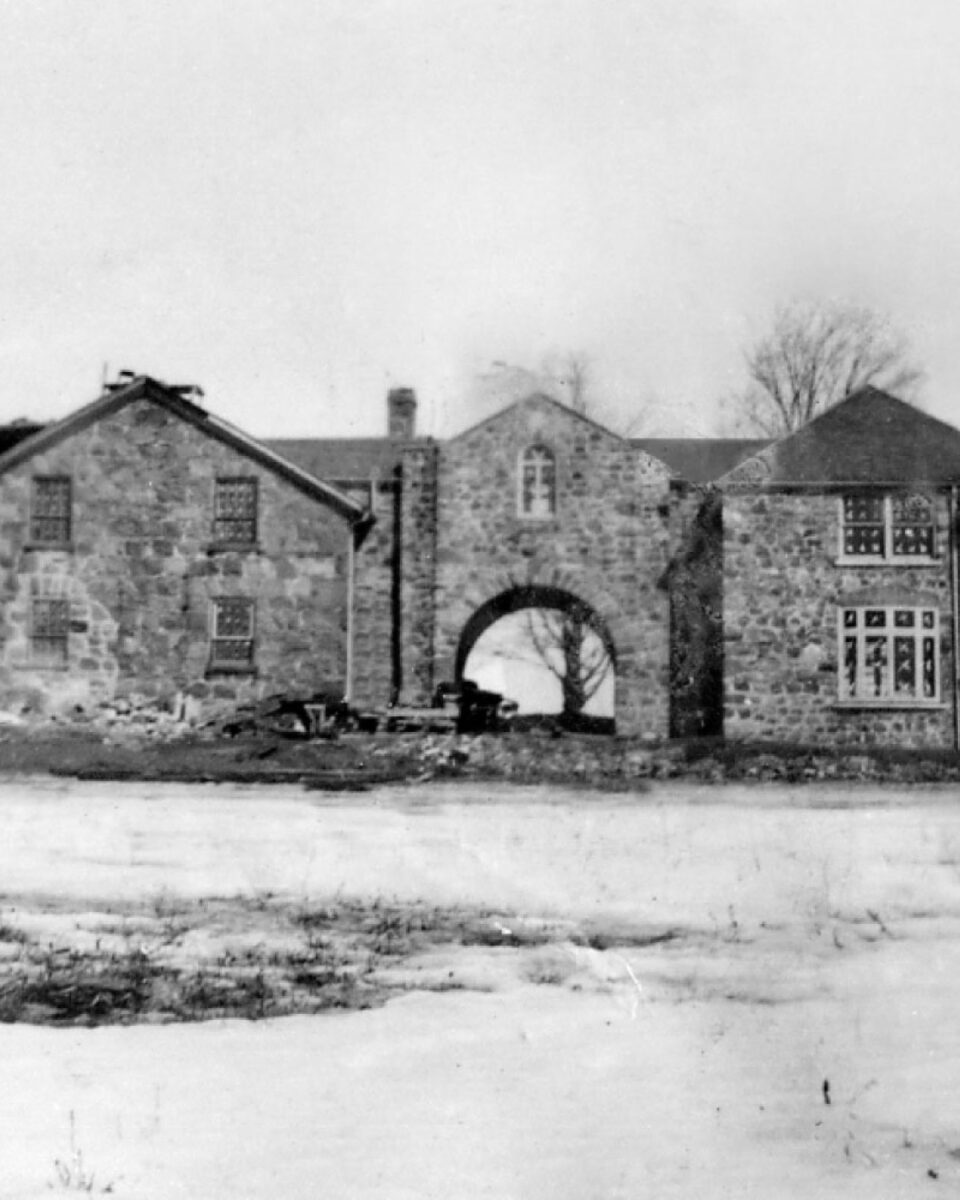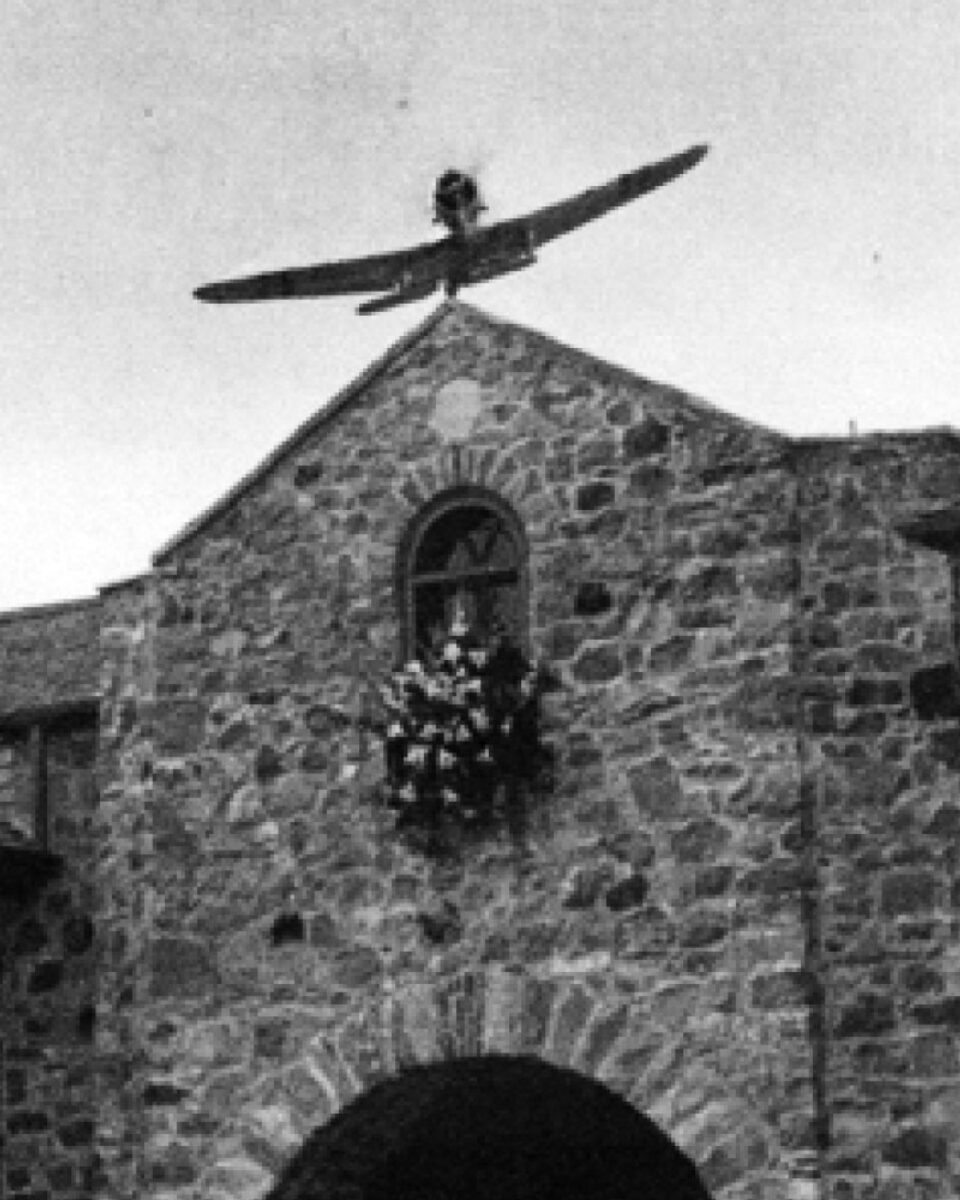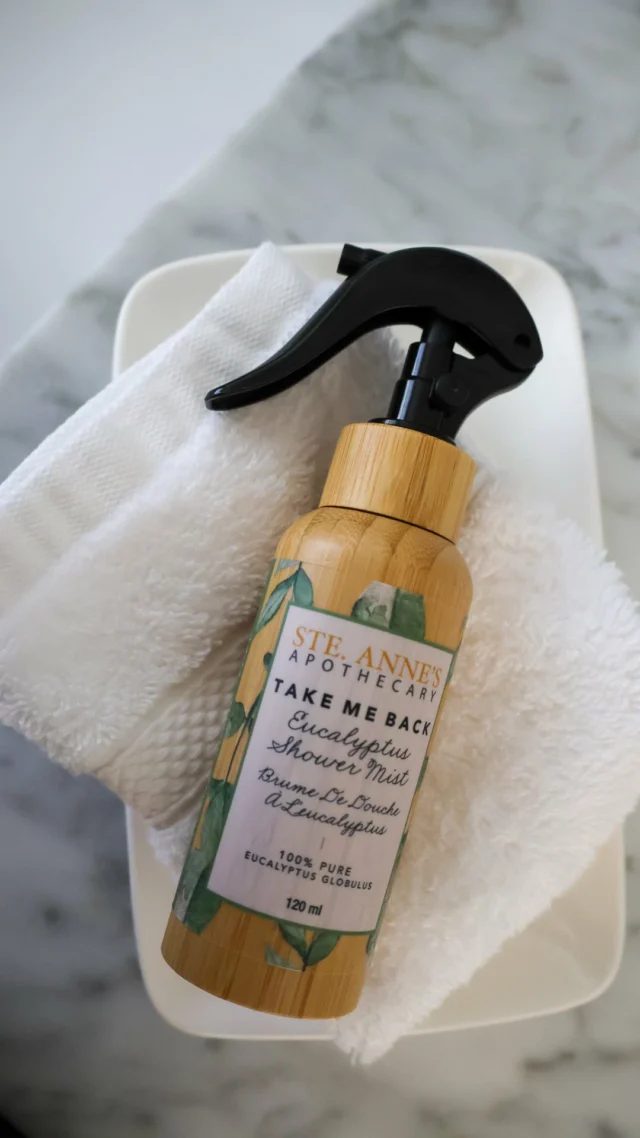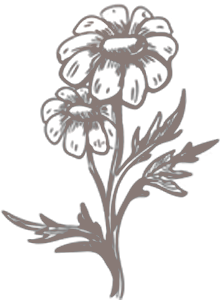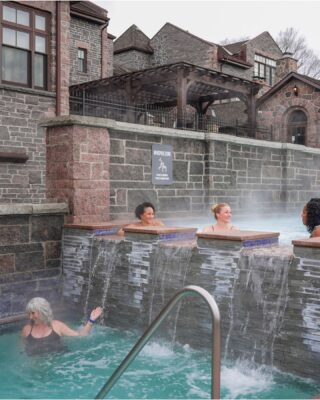The Corcoran Family
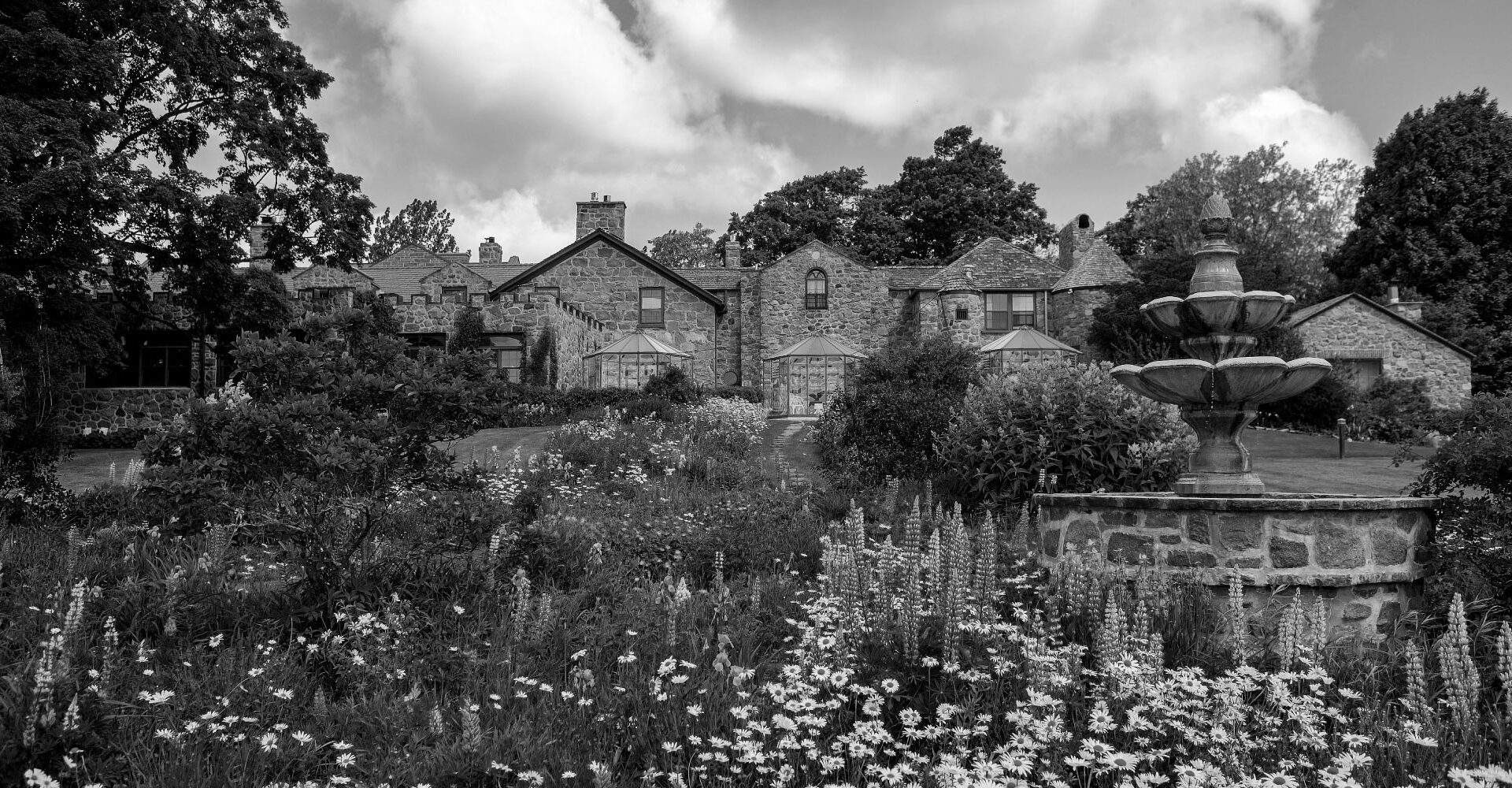
In the spring of 1981, a newspaper ad offered a castle for sale in the Northumberland Hills. A castle? Carl Corcoran was intrigued. His wife, Nan, drove out to take a look at the place. Harold Winter took Nan through the old stone house…by flashlight. It did not show well and it smelled of mould and mildew. Nan returned home and said, “Forget it!”
Carl had to see for himself. He drove out to look a few days later, and agreed, “It’s too far gone.” But they were smitten and drove out several more times to look it over, all the while laughing at themselves for even considering such a huge commitment of time and energy. They were already busy enough. While Carl had been climbing the corporate ladder at IBM, from salesman to president, work often kept him away from home. Nan saw to the day-to-day details of raising their seven children and running the family farm near Kleinburg where they raised Charolais cattle. Carl and Nan kept thinking about the property, though, and mentioning “the castle” to their friends. Carl liked the idea that the family could work on the restoration together. When it was complete, a big house and all that land offered unlimited possibilities for retirement projects.
Nan was drawn to Ste. Anne’s by something less tangible. She sensed a spirit there, a nurturing spirit. Certainly, there was the name of the place to associate with divine healing and the structure itself contained quartz, believed to have healing properties. Also, Nan observed that healing herbs persisted in the long-neglected gardens. Nan’s impression was later confirmed by a family friend, Jay Rawlings, who is well-known as a gifted prophet. When he visited Ste. Anne’s, he received and conveyed a prophecy:
I have chosen this beautiful garden, where I will send many people to be healed.
Carl’s father, Jim Corcoran, had owned and operated a hotel, the Clifton Inn, in Niagara Falls, Ontario. Nan’s father, William Priddle, was a doctor in Toronto. Perhaps it was inevitable that their offspring would combine the two vocations. In June 1981, the Corcorans bought Ste. Anne’s. Since then, all but the eldest of their seven children have been involved in the enterprises there. That first year, their son, Jim, brought a friend out to spend the summer at Ste. Anne’s. They expected to do some cleaning up and make repairs and maybe do some painting. Another son, John, and his fiancée, Nancy Rayburn, came out to help. Jim remembers that they started to restore the swimming pool that summer in order to have a place to cool off and refresh themselves after the gruelling work on the house. The pool was more like a cement pond complete with lily pads. The Blaffers apparently had never used chlorine and the pool had to be sandblasted before it could be used. They pumped water from the well to refill the pool, but at the time they were unsure of the well’s capacity, so they were cautious. The 130,000 gallons required to fill the pool caused no problem with the water supply. John recalls saying, “This is pretty fantastic.” However, the idea to bottle the water came years later.
The Corcoran family soon realized that restoring Ste. Anne’s would take a lot more than cleaning and painting. Years of freezing and thawing had taken their toll. The structure was damaged and the interior had to be rebuilt, room by room. However, the oldest part of the building, the section built in 1858, was in the best shape of all and actually required very little work.
What followed was two years of construction with a crew of sixteen workers, nine of whom lived on the site during the week. Nan says, “It was like a work camp for two years.”
Just before his parents bought Ste. Anne’s, Jim dropped out of York University where he had been studying law and political science, reasoning that he could learn more about politics performing his duties as a school trustee. In 1981, he was in the middle of his third term as trustee with the York Regional Public School Board, a position he had first been elected to while still in high school.
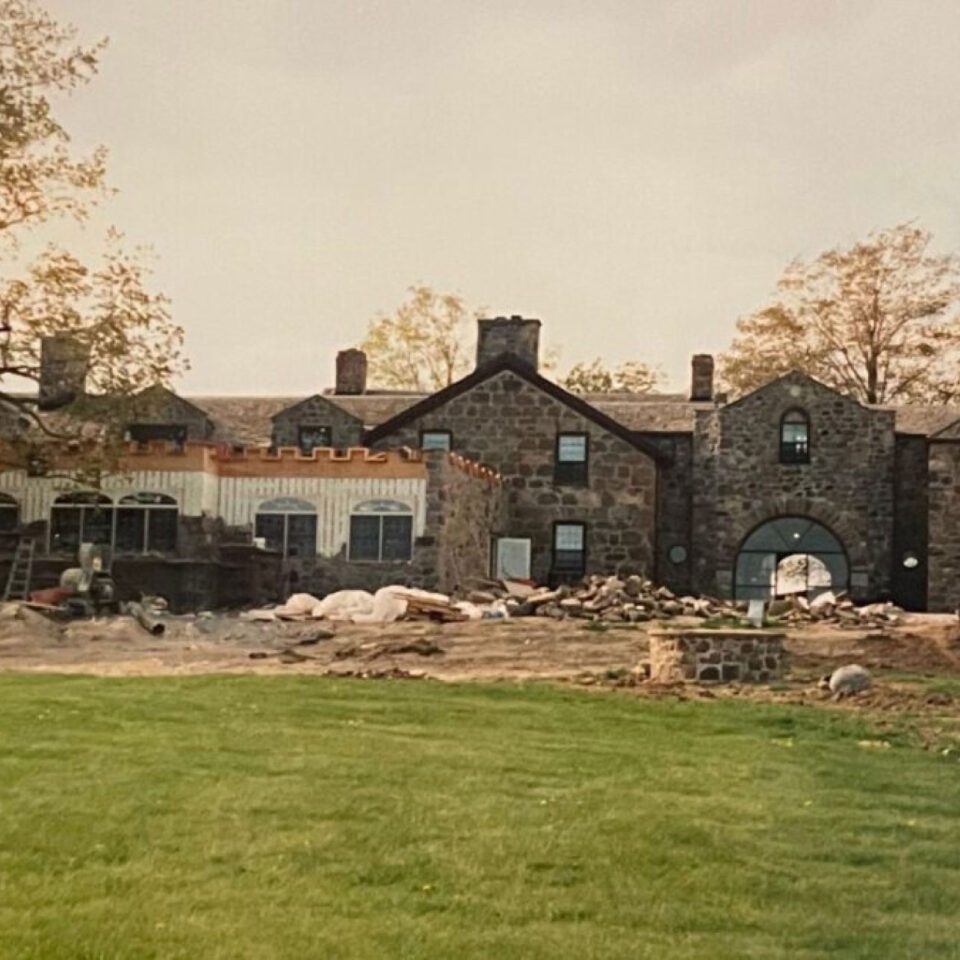
As a trustee, he had served for a time as chairman of the planning and building committee for the board and had been involved in selecting contractors for new school construction. By the fall of 1981 Jim made the difficult decision to resign his seat on the school board and devote all his time and energy to the work at Ste. Anne’s.
Meanwhile, the family had moved to Ste. Anne’s, cows and all. Their furniture was stored in the sitting room. Everyone slept on mattresses on the bare floors, while bats came down through holes in the ceiling and flew overhead at night.
Each morning, Nan cooked for her family as well as the nine extra workers amid the chaos and mess. Carl often left for his office in Toronto wearing a thin layer of plaster dust.
Everyone soon realized, as it got to be very cold, that the heating system was woefully inadequate. Ste. Anne’s had been a summer house, after all. The two existing furnaces could barely take the chill from a fall night, never mind heating the place for winter. Before the new boiler system could be installed, one of the pipes in the sitting room ceiling burst, soaking the stored furniture. The plaster walls in the additions were removed so the electrical wiring and plumbing could be replaced throughout and so insulation could be installed. Layers of paint were stripped from the floors.
When the false ceiling in the room above the library had to be torn down, the beautiful cathedral roof was discovered. It was left exposed in the guest room now called the Cathedral Suite. Jim devoted two years to the renovations and to completing the basic shell. He says, “I took a great deal of pleasure in getting it to that state.”
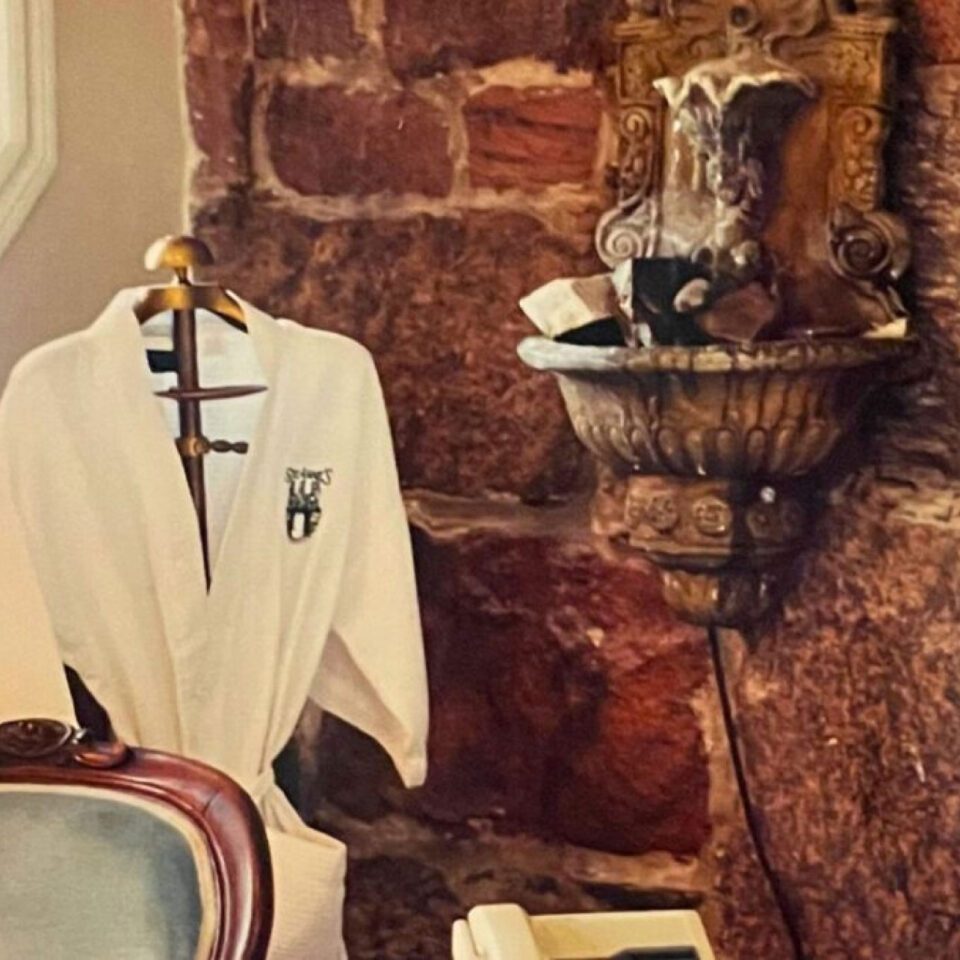
“It was almost magic,” he says. “People came and asked if they could see through the house. They brought their friends, and some even asked if it would be possible to stay in the house overnight. It was apparent,” he adds, “that in a way they felt it was theirs.”
As the renovation neared completion, Nan searched through local antique shops and auctions. She furnished the rooms in a mixture of styles and periods reflecting the way an old house’s furnishings would have evolved over the years. Even the light fixtures had been removed because of vandalism and appropriate replacements were found. A few pieces of the Blaffers’ furniture had been left with the house: the tall cupboards in the library, some bentwood chairs and a cherrywood butler’s pantry.
In May of 1983, John and Nancy were married in Grafton. The wedding reception was held at Ste. Anne’s, literally the moment renovations were completed. The bride-to-be was helping complete the final touches, staining the floor in the East Wing, where the dancing would take place just hours before her wedding.
For the reception, a tent was set up in the courtyard to accommodate 300 guests. The attendants wore shades of peach, white daisies and other local spring flowers provided the decorating theme.
John and Nancy also had been busy renovating the farmhouse next door where they would live after their return from a honeymoon in Bermuda. (Harold and Ada Winter had moved to a house in Colborne).
Nan and Nancy began operating a typical B&B operation at Ste. Anne’s in 1983; however, they soon decided to add some spa treatment options. Nan and Carl’s daughter, Cindy, had recently completed her training as a Registered Massage Therapist and she inspired the change.
Cindy’s interest in massage therapy had first been sparked when she attended a workshop in Detroit a few years earlier. There she learned that massage therapy is a highly respected part of the health system in Europe, used to treat serious conditions. “It is based in science,” she says. “Practitioners must know anatomy and physiology.”
Massage therapy did not become available at Ste. Anne’s until years later but, with Cindy’s help, Nan and Nancy did bring together some qualified assistants so that guests could book three or four-day spa packages which included aromatherapy, “detox” baths, natural facials and exercise classes.
It was during this time that Margaret Pearson, a great-granddaughter of Samuel Massey, visited Ste. Anne’s. She was pleased to see the restoration of her family’s former home and presented the Corcorans with a Massey family heirloom quilt, which is now displayed in the centre hall of the original part of the home.
At first, the Corcorans expected farming to be the main purpose of the property. John had been studying animal husbandry and crop science in Guelph, but when Carl had trouble finding a suitable manager for the farm, John dropped out of university to take over. Carl credits John for the quality that developed in the Charolais herd at Ste. Anne’s. John, in turn, credits Joe Rye, who became a farm manager but now works with John in the water business. With Joe’s guidance, John brought bloodlines from out west into the herd at Ste. Anne’s. One of the Corcorans’ bulls was judged Grand Champion at the Royal Winter Fair. “Joe,” John says, “has a judge’s eye.”
Over the years, more surrounding farmland was purchased. The former Scott farm became home for a while to fallow deer imported from New Zealand. Then, there were other changes to the farming aspect at Ste. Anne’s. “It’s all very well to win prizes,” Carl says. “That’s not necessarily the place to put your money.” The Charolais cattle were replaced by a herd of 500 elk, bred for their antlers which are made into a health-food supplement. But as the emphasis for the use of the property shifted, the livestock operations were phased out.
In 1985, Carl’s job took him to Japan for three years. Nan and their youngest daughter, Marijo, accompanied him. John and Nancy moved into the stone house and Nancy continued to operate the B&B. She had students to help part-time, and her “right hand,” she says, was Sheila Bryan who is still a member of the housekeeping staff at Ste. Anne’s. Even with the help, Nancy had to discontinue the spa options. Most of the guests at that time were regulars who returned often. “It was like having friends visit. We’d invite them to have supper with us, and everyone felt like part of the family,” Nancy says.
In 1985, the old wooden garages to the west of the house were torn down and a new wing was added. This addition contained an extra guest room with a conference room (now treatment area) below.
The water bottling business was started around this time, in a small way at first. When guests continually commented on the great-tasting coffee and teas they were served, John began bottling water for them to take home.
Carl and Nan returned from Japan in 1988 and Carl retired from IBM. The former Kidd farm adjoining Ste. Anne’s had been purchased and Carl and Nan moved into the oldest house on the property which had been renovated for their return.
Marijo had already returned to Canada after only six months in Japan. Her eldest brother, Bill, and brother-in-law, David Storey (Cindy’s husband), helped her get a job in the film business in Toronto. David still works in the film industry there, and Bill is a director, working mostly in B.C. and Los Angeles. Marijo started out sweeping floors but worked her way up to camera assistant.
Marijo’s marriage to Stani Veselinovic was held at Ste. Anne’s in August 1989. The groom’s relatives came from Yugoslavia. The Serbian Orthodox ceremony took place outdoors in the archway. The only attendants were three-year-olds—a niece and a nephew—in old-fashioned costumes. “It was quite lovely,” Marijo says. “The hydrangeas were in full bloom.”
Marijo was a teenager still in high school when the Corcoran’s moved to Ste. Anne’s, and so she had worked at various jobs around the inn when she was younger. In addition to her career in the film business, she trained in aromatherapy, which fueled her interest in natural healing. She is back on staff at Ste. Anne’s and, for the past three years, in charge of marketing and promotions. With her help, the inn has become so well-known and popular that guests usually have to make reservations weeks in advance. Marijo is also very proud of the role she plays in ensuring that the products and processes used at Ste. Anne’s are good for the environment as well as the guests.
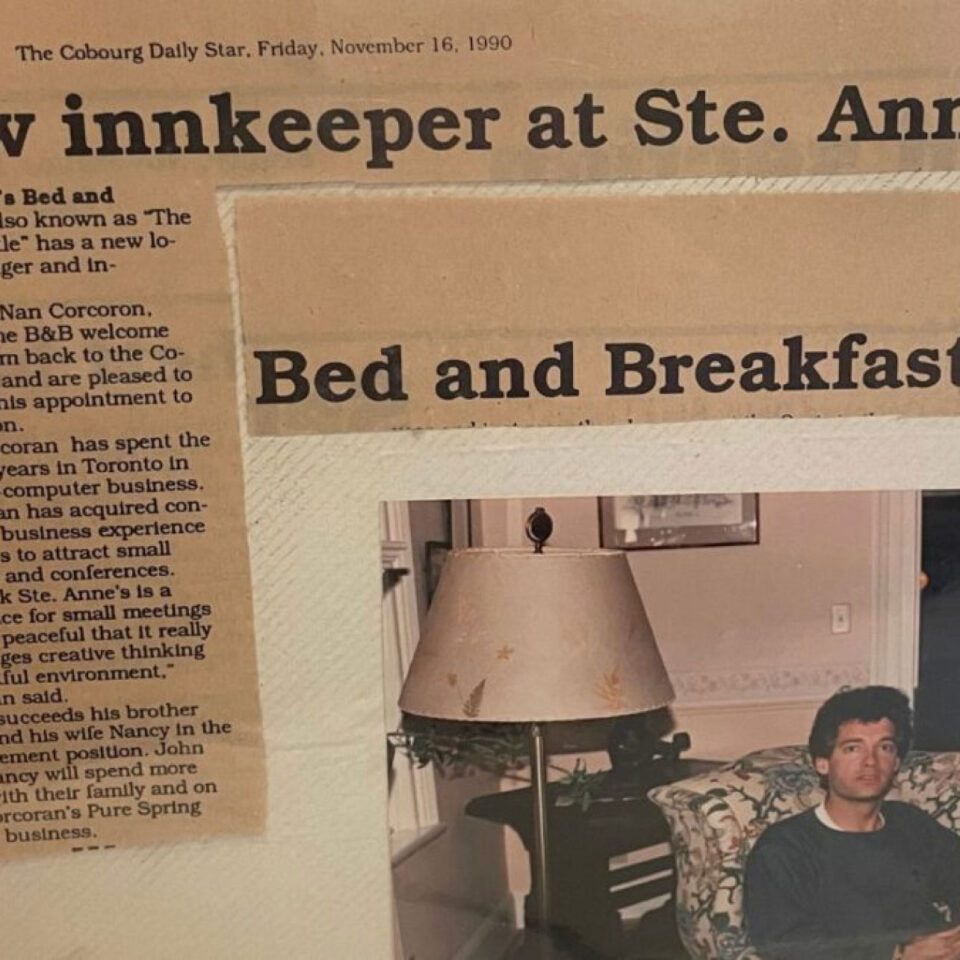
The B&B operation was doing well but Nancy, who now had two youngsters, needed more time for her family, and John wanted to focus on developing the bottling business. The popularity of the water sparked the development of a small bottling business. John, in partnership with his brother-in-law, Jim Abernethy (Cathy’s husband) trucked water from Ste. Anne’s to a facility in Oshawa where they bottled and then distributed it in the local area.
The demand for the water kept growing and the operation eventually had to be divided. Jim and Cathy took over the distribution of bottles of Ste. Anne’s pure spring water and John focused on bottling.
John had a new building constructed on-site with commercial-grade wells and a completely closed system of holding tanks and air filtration to ensure quality control. “The number of gallons drawn from the aquifer is based entirely on the recovery rate,” John explains, “which means we are not mining the resource.”
The size of the aquifer from which the great-tasting water is drawn cannot be determined. It is considered unconfined and the upper limit is unknown.
CJC Bottling Ltd., now a major enterprise of which John is president, did not create its own brand name, and bottles for other labels.
Jim had moved to Toronto when the renovations at Ste. Anne’s were completed and, by 1990, had been working there for Computerland for eight years. One weekend, he was visiting Ste. Anne’s and travelled to Prince Edward County, an area of thriving B&B businesses, to distribute brochures. He was thinking about the possibility that his family’s own B&B operation might be closing. While crossing a street in Wellington, he says, a strong feeling came over him. “It was a significant event.” Jim believes he had “a calling” that day, and suddenly knew that he should be returning to Ste. Anne’s.
He asked his father to let him take over the innkeeping business, but Carl discouraged the idea. Jim had a good job and was making a good living. Carl did not want him to risk losing that. Jim persisted. Using the latest software, he drew up a business plan and a financial forecast which impressed his father enough to change his mind.
Jim took over in the fall of 1990 and began expanding the business his parents, John and Nancy had started. When John, Nancy and their children moved to a newer house on the former Kidd farm, Jim was able to convert their living quarters to guest rooms. Jim lived in a small room above the kitchen which had been maid’s quarters in the Blaffers’ days. A second living room for guests was converted into what is now the Parlour Suite. Thus, the inn’s accommodations grew from seven to ten rooms.
At Christmas of that year, Jim’s sister, Anne Harris, her husband Paul and their children visited Ste. Anne’s and helped redecorate the Cathedral Suite. Over the years, whenever they visited, they enjoyed pitching in to help with any ongoing projects, so Jim proposed that the Harris family move to Ste. Anne’s to help him run the inn. The following June, they moved from their Connecticut home into the farmhouse next door to the inn. It was vacant by then because the cattle had been sold and the farm manager had moved.
Anne helped Jim operate the inn, while Paul worked in the water business, developing sales routes. Anne is responsible, Jim says, for much of the decorating which gives Ste. Anne’s the authentic “country inn” atmosphere the guests admire.
Anne and her family are now back in Connecticut, but during the four years, she and Jim worked together Ste. Anne’s started to flourish and expand. Jim and Anne continued the tradition of inviting regular weekend guests for dinner. However, as the inn became busier, the dinners became harder to manage. For a while, they had meals catered by a local restaurant, then hired a chef. This led to other changes. The kitchen had always been set up as a family kitchen and informal gathering place. As meal preparation became more professional, traffic through the area caused problems.
Jim decided to build an addition to the front of the then dining room, to connect the east and west wings without going through the kitchen.
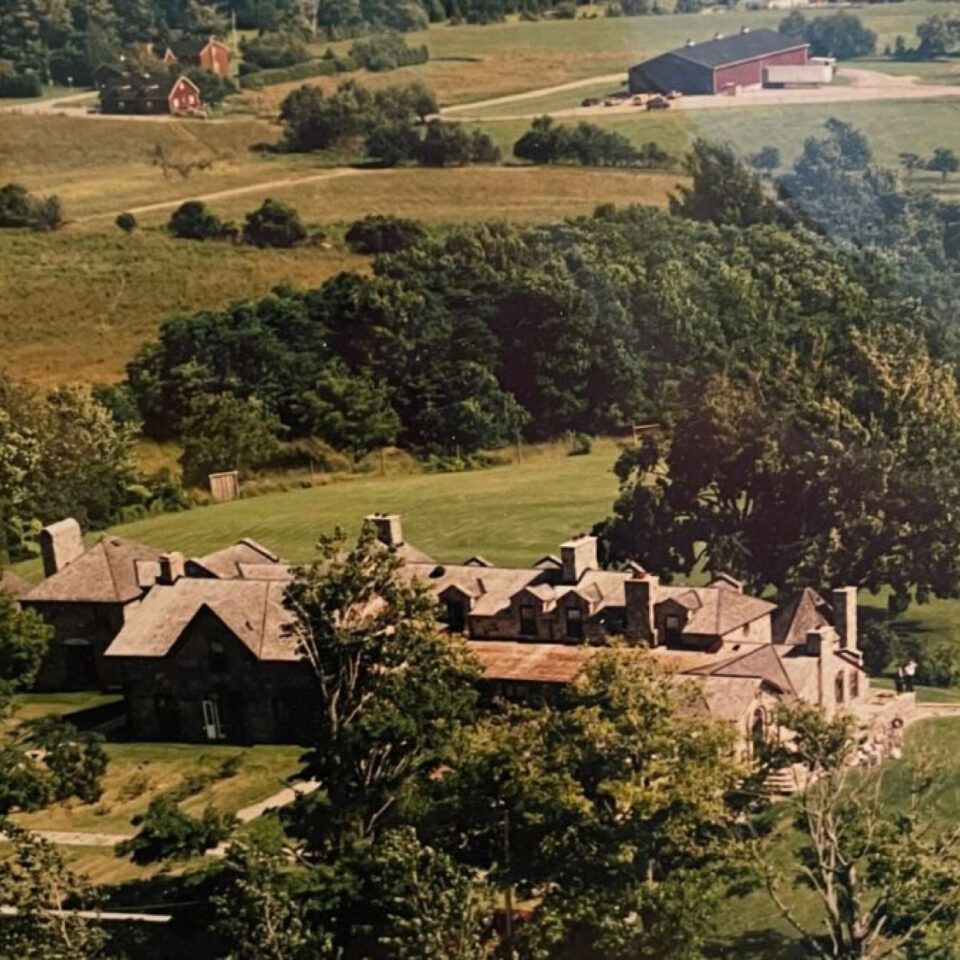
He did not realize it at the time, but it was to be the first of many additions, each carefully designed to blend with the existing structure and add to the efficiency of the inn. That first addition became the regular dining room, and later was transformed to the front desk area.
Jim began looking for ways to market the inn’s accommodations. He attended a forum of country inn operators who were trying to form a B&B organization for Ontario. (Up to that time, there were no B&B organizations). Since, as Jim puts it, “I was not shy to state my point of view,” he was appointed to a steering committee to determine the potential of forming an organization. It was a struggle to bring varied and sometimes conflicting interests together, but eventually bylaws for membership were drafted. When the Innkeeper’s Association of Ontario became official, Jim was elected to serve as its first president for a term of two years.
From the start, Jim tried various innovative marketing strategies. At one time, he arranged for Ste. Anne’s to host a series of artist-in-residence workshops where guests could study and paint with their favourite new artists. At about the same time, temporary spa treatment areas were set up, and his sister Cindy began offering treatments to weekend guests.
Cindy was living in Toronto and providing massage therapy for the staff at Ray Civello’s salon. Ray was the pioneer in introducing Aveda products to Canada. Cindy and other staff members from Ray’s salon came to Ste. Anne’s on weekends to offer treatments to guests. Jim says it was immediately apparent to everyone at Ste. Anne’s that the guests who signed up for a massage or facial and were there for two nights rather than one were much more relaxed at check-out time.
As the benefits to guests became more and more obvious, Jim realized that the Ste. Anne’s experience was incomplete without the spa component, and that soon became a mandatory part of the stay.
The seldom-used conference area in the west wing was converted to treatment rooms, and a gift shop was set up nearby where guests could purchase Aveda products for home use.
Jim began to search for permanent staff for the spa. Unusual circumstances surrounding the hiring of two people who were recruited around that time are among the magical coincidences that occur at Ste. Anne’s.
Nancy Burns had just completed a course in aromatherapy when someone from the inn approached her to consider taking a position at Ste. Anne’s. When Nancy came to the interview she had not heard the name Corcoran and did not meet any of the family, who happened to be away on vacation. She almost did not accept the job because it was a long drive from her home. The inn called a second and then a third time. Finally, Nancy decided that Ste. Anne’s would be a beautiful place to work and “the drive was not so bad.” Nancy had been working at the inn for about two weeks when she saw Anne for the first time. “My stomach gave a lurch,” she says. “Anne looked a lot like my mother.” Nancy did a little checking and learned that Carl Corcoran was one of the owners of the property and that he had worked for IBM. She realized he was her Uncle Carl, half-brother to her mother. “We had lost touch for years,” she says, “and to be reunited in that way was a gift.”
Nancy worked as an esthetician and was Spa Director for a time. Now she is in charge of the gift shop; and it was Nancy who convinced Jim to move the shop from a cubbyhole in the basement to its present location in the former Blaffer dining room.
Rebecca Ryan believes that she was meant to be a part of Ste. Anne’s, too. In 1995, Rebecca had been working as a Registered Massage Therapist for four years. She treated many patients suffering from chronic pain, often the result of bad traffic accidents. She found that she was doing more paperwork than therapy, filling in insurance forms and testifying in court cases. She was ready for a major life change.
About four months prior to receiving a recruitment letter from Ste. Anne’s, Rebecca had a dream about working at an old stone building under renovation. “It was a vivid dream,” she says. “I kept it tucked away in my mind.”
While touring Ste. Anne’s during her interview, Rebecca realized it was the stone house from her dream. She immediately accepted a position as Massage Therapist at the inn, then returned home to close her practice and sell her house. Over the years at Ste. Anne’s, Rebecca has been Manager of Massage Therapy, Spa Director, General Manager, and is currently Director of Product Development. “We’ve really made a transformation from an inn,” she says with satisfaction. “It is now considered a destination spa.”
As the healing effects of the spa treatments became the most compelling feature of Ste. Anne’s, more additions to the structure were required.
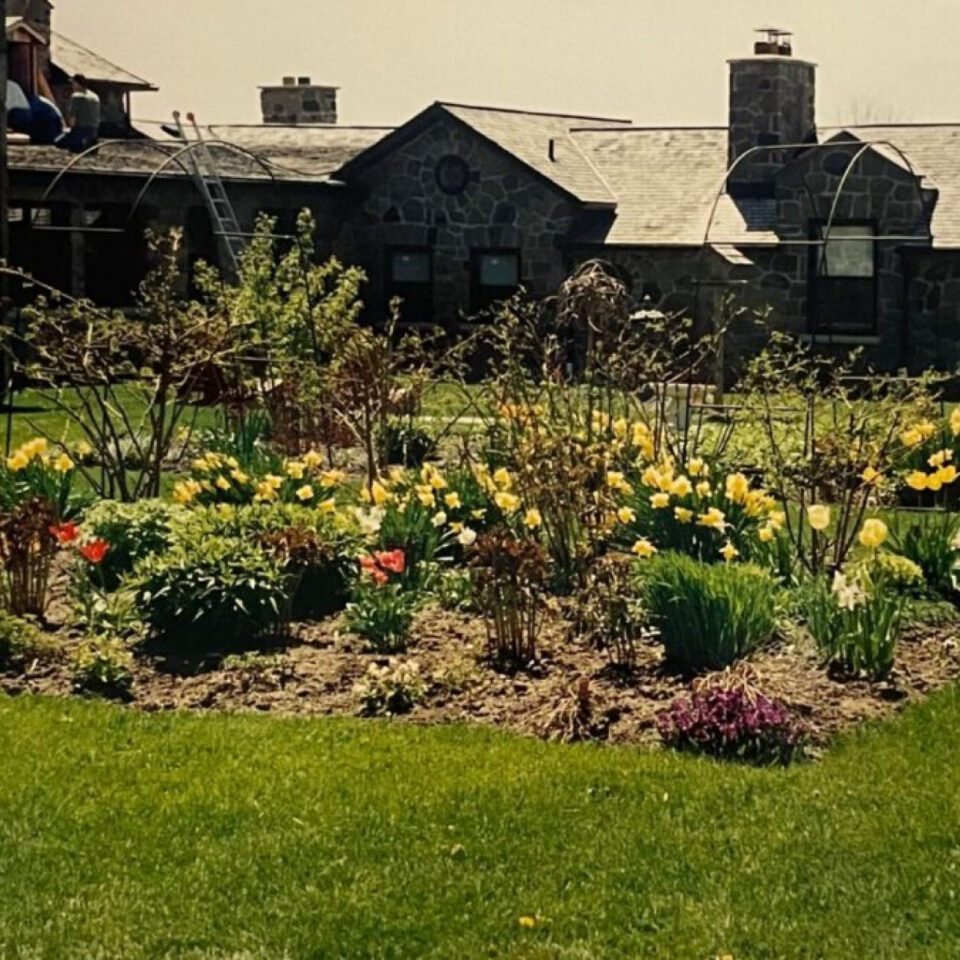
He had also been a pioneer in the field of geriatric medicine. Nan’s father and mother were frequent visitors to Ste. Anne’s. In fact, it was Agatha Priddle who first encountered the ghosts. After all, what a self-respecting castle would be without a ghost or two! Two ladies in long black dresses and dark cloaks were first seen by Mrs. Priddle, and a few other guests have also spotted them, though not recently. Several years ago, a neighbour told Nan quite nonchalantly that the two ladies “have been there forever.”
When the excavation for the larger dining area was underway, the top portion of the Massey’s stone well was carefully removed and placed as a “wishing well” on the south lawn.
As this work continued, the backhoe tapped through a section of the foundation at the rear of the old building. Jim then decided to dig out the crawl space connecting all the basement areas, which created more area for treatment rooms. The Blaffers’ dining room, with its black and white marble floor, became the gift shop.
In 1994, a large addition was made to the circular playhouse to serve as the innkeeper’s residence, but Jim found himself moving out so often to accommodate extra guests, it is now an additional suite.
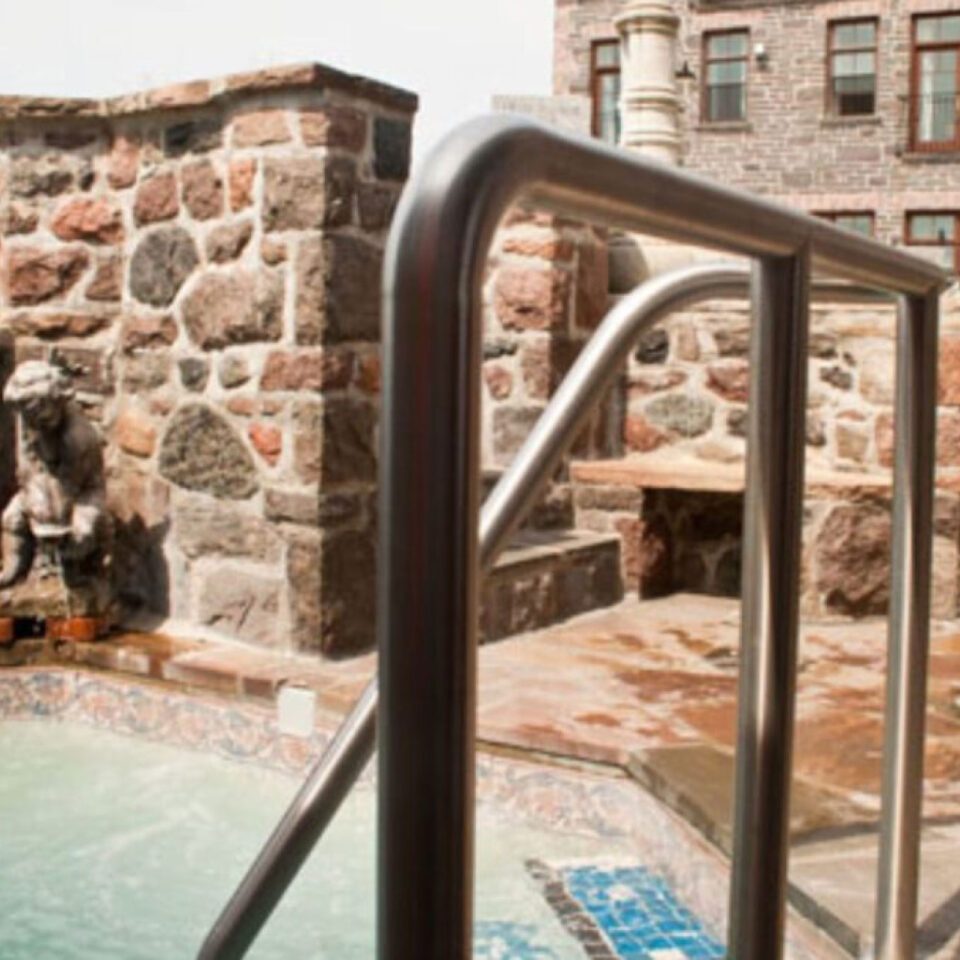
The character and the style of each addition to Ste. Anne’s complements the original structure. The architect who helped Jim design most of the additions was Hugh Taylor of Cobourg. Frank and Jim Guest, owners of Kawartha Stone Masters, can be credited for the construction and are still involved in regular maintenance and future expansion plans.
There are ten guest suites at the inn itself and a total of twenty-five treatment rooms. The inn’s accommodations also include some off-site suites. The farmhouse next door, built by Simon Jayne, has been renovated into two suites: the Farmhouse and the Gables.
The brick schoolhouse at the top of Academy Hill had been converted to a private residence years ago. When it became available, it was purchased and renovated into Haldimand East and Haldimand West. Jim says that the renovation job was one of the worst encountered and cost more than the purchase price.
As other properties became available, the Corcoran’s added to Ste. Anne’s holdings. Many of the houses are used for staff accommodation or administration.
Bill Corcoran, Nan and Carl’s eldest, was already working and moved away from home when his parents bought Ste. Anne’s. Although he jokes that he “escaped the renovations”, he did stay and help out for about a week that first year. His film work takes him to many exotic locations, but he visits Ste. Anne’s as much as possible and has a special feeling for the place. “The house told us what it wanted to be. It guided the restoration. It brings out the best in people. We all really feel a wonderful healing process that happens at Ste. Anne’s,” he says.
When Bill and his wife, Julie, were married in September of 1997, they chose to have the wedding in Grafton so the reception could be held at Ste. Anne’s. They hired a quintet for the church which came back to Ste. Anne’s to play before dinner. Later, a band set up in the Fitness Pavilion and played 40s and 50s dance music.
Bill and Julie arranged to take over the whole inn for the weekend and kept the staff on so their guests could have full spa services. People came from California, Texas, and Connecticut and “many had never had spa treatments before”, Bill says. “We felt like we were giving a gift back to our guests.”
The healing effects of the spa treatments and the atmosphere at Ste. Anne’s are a source of great satisfaction for the Corcoran family. Carl points out that over the years they have received “a constant stream of wonderful thankyou letters. The scenery and everything here is like a different world. Guests walk through the archway into the walled courtyard and feel protected and enveloped. That’s a big satisfaction for us and for the staff—the effect it has. It’s like a hospital where everyone is cured.”
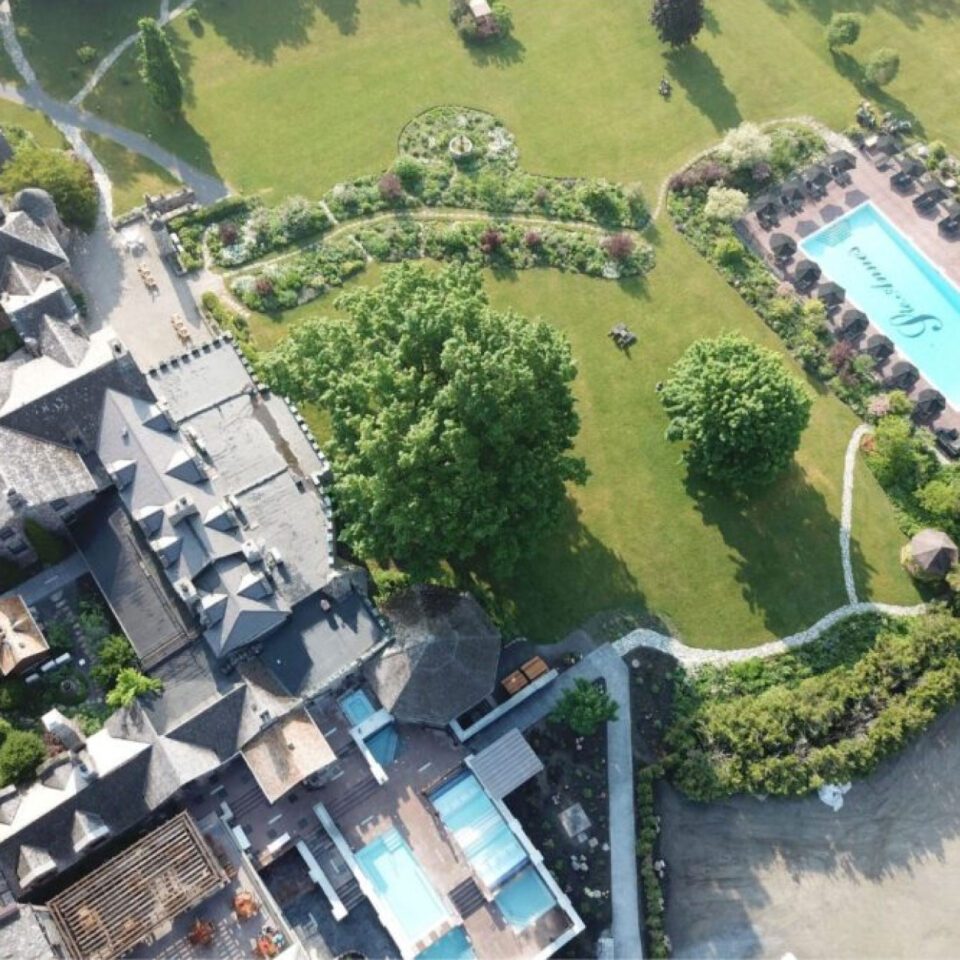
Jim has a major and innovative expansion planned for Ste. Anne’s. The plan includes individual, self-contained spa resorts on the 560-acre property. When completed, this expansion will make Ste. Anne’s one of the most unique resort complexes in North America and will increase the inn’s accommodations to 250 rooms.
Throughout its history, a series of hardworking, dedicated families—people who were pioneers of their time—have been drawn to this place. The stone house built by Samuel Massey was fine but not unique. It was the setting that captivated Mrs. Blaffer and inspired her to create a “castle” here. The Corcoran family came, intending to farm, but the size of the building and the local pride in the “castle” led them to develop an inn which has evolved into a spa.
Before the therapists were present, Nan Corcoran sensed a healing spirit here. Before the treatment areas were created, a prophecy foretold their purpose. Many cultures attribute sacred significance to lands where waters flow underground. Long before people left their mark on this land, arranged its stones into structures, and named it Ste. Anne’s, this was a special place.


